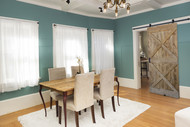How to Decorate a Dining Room
Nov 7th 2017
Many of the rooms in your home can serve whatever purpose you choose. For instance, your living room can be a formal gathering place for guests or an everyday recreational area for the kids. However, the dining room specifically provides a space for your loved ones to gather in to enjoy a meal. So when it comes to the task of decorating a dining room, you have to think about the function as well as the style and design.
Know Your Space
As with almost every other interior design project, you want to begin the process with measurements. You need to measure to find out how long, wide, and high the space is so you know how to decorate your dining room without overcrowding or underfilling it.
When you take these measurements and begin shopping for furniture, remember that it should be easy to move in and around your dining room. Serving a meal to your whole family is hard enough without obstacles getting in your way. Many interior designers recommend 32 to 26 inches of space between the back of each dining room chair and the wall and/or another piece of furniture. If this pathway is going to be a high traffic area, allow for 24 to 28 inches of space.
Lighting
A dimmer switch for lighting in your dining room allows you to take this space from romantic and intimate to welcoming and festive with ease. A big family gathering for a holiday requires a lot of light, whereas a quiet dinner for two can use much softer light and make good use of candles. You can always increase or decrease the amount of light in the dining room by opening or closing the sliding modern door you’ve installed (which are currently on sale for 30 percent off with promo code THANKS30 through the end of November).
Also keep in mind that if you select a chandelier for your dining room, you’ll want it hang at a height of about 30 to 34 inches above the table, if you have 8 feet high ceilings. Hang the chandelier 3 inches higher for each additional foot of height in your dining room.
Filling the Space
The best way to determine the right type of table for your dining room is by considering the space itself. Experts recommend rectangular or elongated oval tables for larger or narrow dining rooms. Round or square tables work well in small or open-concept dining rooms. You can also buy dining room tables with removable leaves that make it easy to adjust the size depending on the number of guests you are hosting.
As for chairs in your dining room, the most important thing to keep in mind is that they comfortably fit under the table and allow for enough elbow room between each person. You can buy a dining room set, which will come with a table and matching chairs, or you can mix and match different ones to compliment your own personal interior design style.
Sideboards, china cabinets, and buffets are wonderful additions to your dining room that can serve double duty, both as storage and for serving. These pieces only work if you have the space for it because you want there to be plenty of space in the pathways. For a smaller option that’s equally as helpful, try a bar cart or a rolling counter space.
If you are considering a rug for your dining room, remember to use one that is big enough to chairs won’t catch on the edge of it. The easiest way to find a rug that fits in your dining room is to select one that is 24 to 30 inches longer and wide than your table. This allows for enough space so the chairs remain on the rug, even when pushed back from the table.
Hanging Art
A dining room is a perfect place to display your favorite pieces of art. You can really wow guests while building a conversation around a breathtaking artwork. If you are going to hang a single piece of art on wall, it should be at eye level with it’s center 56 to 60 inches above the floor. The same measurement applies if you are going to hang one piece above another but treat them as one large piece to determine the center.
If you want to create a gallery wall of artwork in your dining room, space pieces one to three inches apart, depending on their size. Smaller pieces can be be 1 to 1 ½ inches apart while larger ones might need 2 ½ to 3 inches of room on the wall.
Once you’ve selected a color palette, furniture, and artwork, the task of decorating your dining room is complete. For seasonal changes, experiment with different centerpieces for your table or slipcovers for the chairs.
